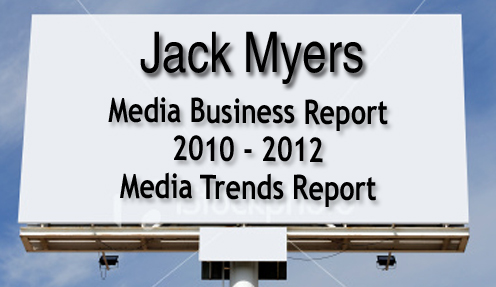Carey, Townsend, Griffin, Balis: Redefining the Magazine as Marketing Platform

You are receiving this e-mail as a corporate subscriber to Jack Myers Media Business Report. Re-distribution in any form, except among approved individuals within your company, is prohibited. As a subscriber you have full access to all archives and reports at www.jackmyers.com. If you require your ID and password, contact maryann@jackmyers.com
PART 6: Myers 2010-2012 Media Trends Report
The magazine publishing industry is undergoing the most radical change in its history as it reels from the loss of more than one-third of advertising revenues since 2007. First veteran Condé Nast executive David Carey departed to lead Hearst Publishing. Then Condé Nast CEO Chuck Townsend announced a major re-focusing of his business that literally redefined the role of the magazine for publishers, editors, consumers and advertisers. And this week, it will be officially announced that Meredith Publishing president Jack Griffin will assume the presidency of Time Inc. Magazines after resigning two weeks ago from Meredith.
In each case, the management shift has reflected a move away from traditional magazine publishing – away from magazines as media. The new management reflects a redefinition of the magazine as multi-dimensional marketing platform. The organizations involved are making a clear commitment to de-emphasizing their dependence on advertising revenues and increasing their abilities to target "below-the-line" budgets including direct marketing, consumer sales promotion, trade promotion, event, social media, conversational marketing, cause related and even search marketing budgets.
Even with the 2010 ad recovery, it's become clear that magazine publishers' dependence on traditional print advertising budgets is unlikely to deliver the growth their parent corporations require, even for the most successful publications. While comparing 2010 growth to the aberrational 2009 recession year looks good, the long term industry prognosis is weak. Consumer magazines' peaked in 2000 at 11.0% share of the total advertising market, declining to an 8.2% share in 2009. Jack MyersMedia Business Report forecasts a slight rebound of magazines' business to 8.6% market share in 2012, but 2012 advertising revenues will increase to only $16.4 billion, down from the high of $21.5 billion in 2007.
If magazines are to significantly increase revenues, they must position themselves to tap into the $11.4 billion that marketers are projected to invest this year in Media Directed Promotion/Event/Sponsorship Investments. These budgets, exclusively analyzed and forecast by Jack MyersMedia Business Report, are expected to grow 22% in 2011 and 30% in 2012, increasing to more than $18 billion dollars in 2012 budgets expected to be available to media companies for non-advertising applications. Today, the most visible of these investments are targeted to sports sponsorships and rights fees, in-store media, media-related events and experiential marketing activities, and entertainment-based marketing programs (movies and music).
In the future, thanks to digital opportunities, traditional media companies will be positioned to target and capture a growing share of these non-advertising investments, and Myers' aggressive growth forecast for this new category is based on our expectation that media companies will commit the necessary resources to target these budgets. The magazine industry should be applauded and hopefully rewarded by marketers for its strategic redirection.
Targeting of these non-advertising budgets is consistent with the DNA of the magazine business. However, over the past two decades publishers have been pushed hard by marketers and media buying agencies to compete based on audience reach and scale, and have effectively disowned their heritage of pricing based on the value of loyal audiences and engaging content and effectiveness in generating response. Although the Magazine Publishers of America have invested more than any other trade associations in research to prove the value of their audiences based on engagement and emotional metrics, it has mostly fallen on deaf – or at least hard-of-hearing -- ears. Ad spending is determined, for the most part, by audience size, demographic targeting, and price.
Last year, new sales and marketing management at Martha Stewart Living Omnimedia, headed by Janet Balis, announced a series of marketing initiatives that required marketers to embrace and financially reward the publisher's magazines for their ability to engage their audiences and generate response to marketing offers and outreach. The results have been positive and sustained. Several years ago, Meredith's Griffin refocused that publisher's business to emphasize direct marketing, capitalizing on the value of Meredith's databases and acquiring direct marketing firms to advance their value. The positive results were significant. Meredith's business grew 4% last year in a market that experienced declines averaging 15% to 20%.
At Time Magazines, one of the bright spots has been the integration of magazine assets into marketing programs developed and implemented by the corporate parent's Global Media and Marketing Solutions Group, now headed by former Y&R creative executive Mark D'Arcy. Again, these initiatives are dependent on cross-media initiatives and the embrace of media as a marketing platform rather than exclusively as a delivery vehicle for advertising messages. The success of this group, and of Meredith's positive results, was most likely a significant influence on the choice of Griffin as successor to Anne Moore at Time Inc.
J.P. Partilla, who had partnered with D'Arcy at Time Warner until last year, left to establish a similar, expanded effort at Clear Channel, signaling that company's effort to reposition its radio and out-of-home business as marketing partner in addition to media asset.
And on the media agency side of the business, similar moves reflect the marketing and multi-platform opportunities being advanced by traditional media companies. While most media agencies are exploring ways to enhance their ability to understand and incorporate marketing capabilities into their service offerings, IPG's Universal McCann, a part of the Mediabrands division, has made it a core aspect of their business model. Under president Matt Seiler and EVP Jacki Kelley, the agency has focused on building enhanced partnerships on behalf of their clients with media companies, emphasizing the expanding availability of below-the-line budgets.


